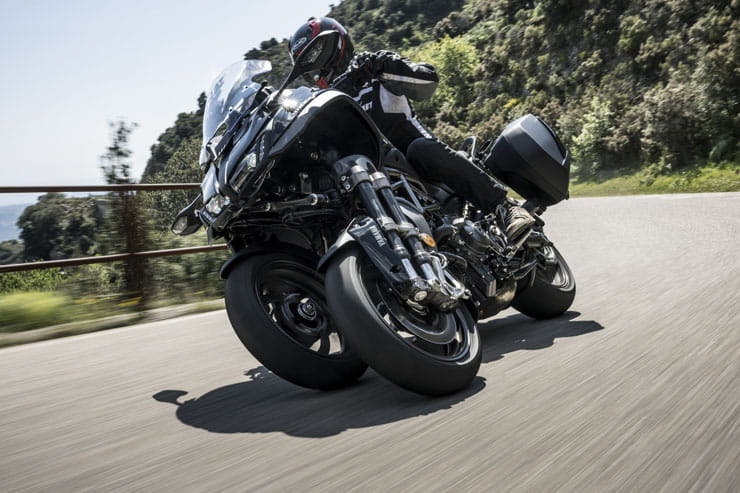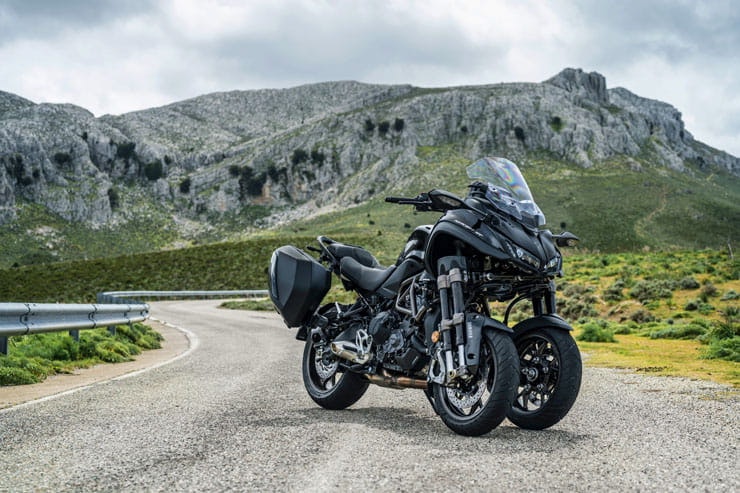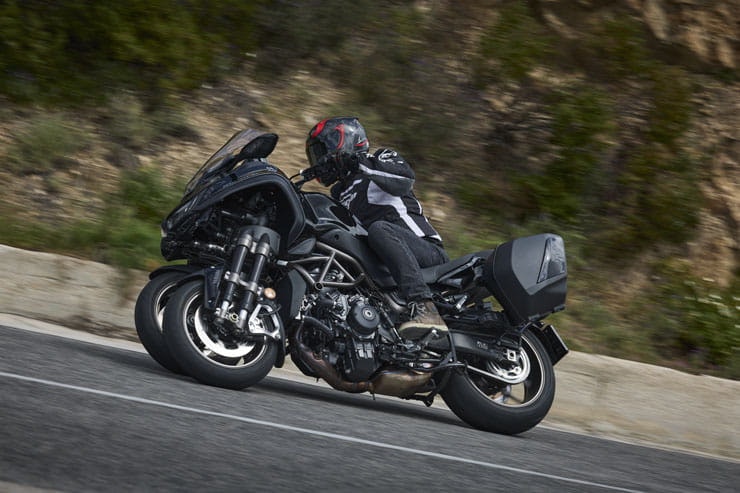Yamaha NIKEN GT (2023) - Review
BikeSocial Road Tester
04.07.2023
Original Technical Review by Ben Purvis – 7 Nov 22
Price: £16,210 | Power: 113bhp | Weight: 270kg | BikeSocial rating: 4/5
Is it a motorcycle? Is it a trike? Is it an abomination under the sun or an example of Yamaha being an adventurous, bold, innovative manufacturer, trying to expand what could easily be described as a sunset industry riddled with conservatism?
Released in 2018, Yamaha’s Niken certainly divided opinion then and still does now. With an engine and chassis based around the then current MT-09 and Tracer 900 inline triple, the Niken employed a novel front end solution. Two 15in 120/70 wheels (from a TMAX) were each gripped by a pair of forks, themselves held in place by pivoting steering arms – the effect was to deliver a hitherto undreamed level of stability and grip to the front end of a motorcycle (or whatever it is). Put simply, it’s nigh-on impossible to lose the front on a Niken, and the intuitive and instant reassurance it gives riders of all calibres is uncanny, almost supernatural.
But that feeling of invincibility comes at several costs. The first Niken was heavy. It was complex. It didn’t look like a motorbike. And it was expensive. Its front end feel might be revelatory, but riders steered clear.
For 2023 the Niken GT gets updated and uprated – in itself, something one suspects might not always have been a given at the factory, considering the machine’s clearly limited audience. The engine is enlarged and uprated to the latest Euro5 CP3 triple, frame and rear suspension is revised, electronics, dash and switchgear is new, and the bike gets a number of convenience upgrades – and the price goes up.
Is it enough to convert a larger number of riders to the Niken way? Or are Yamaha preaching to the already converted? Simon Hargreaves is on the launch in Sardinia to find out.
Astonishing, mind-blowing grip and stability at the front – a genuine revelation
Fantastic CP3 triple engine – one of the best motors in production
Wide array of useful sports touring extras including heated grips, cruise, panniers
Fantastic new clocks and user functionality
It’s not exactly lightweight
Tank range is limited
Price tag demands both-feet commitment to the concept, but...
...can it deliver motorbike-style satisfaction over the long term?
2023 Yamaha NIKEN GT: Review
What is a three-wheeled MT-09 like to ride? Simon Hargreaves finds out.
Review – In Detail
Price, Colours & PCP
Engine Performance, Gearbox, Exhaust & Fuel Economy
Handling & Suspension (inc. weight)
Comfort & Ergonomics
Equipment & Styling
Rivals
Verdict
Specification
2023 Yamaha Niken GT Price, Colours and PCP
The Niken costs £16,210 on the road. There’s nothing to directly compare it with, unless you include rival sports tourers: Yamaha’s stunning Tracer 9 GT is £13,110, the GT+ with radar, same new clocks, switches and panniers as the Niken, is £14,910.
The Niken is thousands more than Suzuki’s GSX-S 1000GT+, Kawasaki’s Ninja 1000SX and Honda’s NT1100. Even Moto Guzzi’s V100 Mandello S is cheaper, at £16,000.
Yamaha Black is the only colour option (not sure how Yamaha’s black differs from anyone else’s black).
PCP example:
2023 Yamaha Niken GT Engine Performance, Gearbox, Exhaust and Fuel Economy
The new Niken is one of the last engines to upgrade to Euro5, adopting the 2021, 120° crank, 890cc, ride-by-wire inline triple from the current Yamaha MT-09 Naked Roadster, Yamaha Tracer 9 Adventure-Tourer and Yamaha XSR900 Naked Retro.
The Niken motor is slightly down on power and torque from those motors, making 113bhp @ 10,000rpm and 67 lb.ft @ 7000rpm (4bhp and 2 lb.ft less thanks to an 8% increase in crank inertia and different fuel injection settings, as per the previous Niken, which alters engine response and removes some of the instant fizz from the Tracer’s motor to better suit the more deliberate dynamics of the Niken).
In fact, these are the same peak figures as the previous, 847cc generation Niken – but with a larger, longer stroke engine producing them, the character of the power and torque delivery is different: peak power is still at 10,000rpm compared to the previous Niken, but peak torque is slightly higher than before and – significantly – 1500rpm lower in the rev range. Yamaha haven’t supplied dyno comparisons, but it seems likely the new engine will have more area under its torque curve than the previous bike.
What all this means is the Niken’s motor hasn’t quite got the same unbridled joy and whizz of the XSR/MT-09/Tracer 9 models – not only a few bhp down on power, it’s also lugging around 50kg more mass than, say, the standard Tracer 9 GT – but it’s still a bounteous engine to buzz about on. The up and down quick shifter isn’t the hyper-versatile new shifter on the Tracer 9 GT+, but it’s still one of the best and allows easy short-shifting with quick-fire gear changes keeping the triple surfing the crest of its torque curve – or straining into the redline when required to make ultra-sharp overtakes. It’s a brilliant engine and adding an extra wheel to the front of the bike scarcely reduces its effectiveness.
It does effect fuel consumption; Yamaha claim 48.7mpg for the Niken and 56.5mpg for the Tracer 9 GT (it also pumps more CO2 into the atmosphere; over the course of ten years and 40,000 miles, a Niken will add 8690kg to the atmosphere; a Tracer will dump 1223kg less. For the record, 8690kg is the weight of 32 Nikens. You could go mad thinking about this stuff).
It means the Niken’s 18-litre tank is good for a claimed 190 miles to empty, but the real world figure on the launch varies between 38mpg to 42mpg – take an average of 40mpg and the total tank range would be 160 miles; minus four litres for reserve and you’re looking at the fuel light coming on at around 120 miles – which is where it does come on during the launch. Love it when a plan comes together. But on a sports tourer as capable as the Niken, that’s not enough. I suppose if Yamaha had managed to squeeze a 22-litre tank on the bike, that would make the kerb weight even more extreme. You just can’t win in the motorcycle engineering game.
The new motor is canted forward by 5° over the previous Niken engine; however Yamaha’s engineers say the bike’s weight balance is still 50:50, meaning it’s as likely to be tilted forward for the sake of packaging – a longer stroke engine could well mean a taller engine. The Niken also has a new radiator; again, this may partly be reshaped for allowing greater front wheel clearance for the tilted engine – but also, for Euro5, the engine will run hotter (because it’s running leaner) and may need a more efficient cooling system.
2023 Yamaha Niken GT Handling, weight and suspension
The 2023 Niken keeps the same massive, cast aluminium headstock, but the mid-section of the frame features a new arrangement of extra cross-member steel tubes, giving the frame a trellis look. It’s an impressive piece of plumbing, but Yamaha say it actually allows the right blend of flex and rigidity in this section of the frame – every tube has a specific diameter and wall thickness to achieve that balance. However, that’s word-for-word what they said about the original Niken – so maybe the new one is just even more righterer.
The front end is the same fully-adjustable set-up as before – the settings were considered ideal in the previous bike. The trailing 43mm fork legs do the suspending and damping; the leading legs are 41mm and for support only.
Details of the Niken’s steering mechanics are detailed in the original launch report but, briefly, the forks are held by linkage arms connected to a main steering column – as the forks steer the wheels manage braking and suspension forces independently, but steer as a single unit with the linkages pivoting to provide lean angle. With the fork legs on the outside of the wheels, lean up to 45° is possible – beyond that, the safest option would be to slow down to prevent running wide. However, the separation of steering and suspension forces, plus the increased grip stability of two contact patches instead of one, mean chopping the throttle mid-turn has minimal effect on steering.
And steering stability and extra grip is what the Niken is really all about, and what separates it from Yamaha’s own very competent sports tourers, the Tracer 9 GT and GT+. Front end grip – or the rider’s perception of it – is instantly and intuitively recognised as, to all intents and purposes, boundless. You can brake hard mid-corner, you can steer across all kinds of surfaces without a thought, you can pitch into slippery roundabouts in the middle of Sardinia – or anywhere – without even considering front grip. It’s simply one less thing to think or worry about when riding – and the level of brain space freed up is remarkable. For a given speed on an unknown twisty road, the Niken feels around 40% less taxing on the old grey matter. Over a day’s ride on miles of back roads, that adds up to extra reserves of concentration.
Which maybe is where the Niken also falls down – you don’t get off feeling as if you’ve achieved quite as much as you do following a similar ride on, say, a Tracer 9 GT+; less tired, definitely; less fulfilled, maybe not. The day after the Niken ride I was lucky enough to test the new Yamaha Tracer 9 GT+ on similar Sardinian roads – and it definitely left me more frazzled. But in a good way. This may matter to you or it may not. There’s only one way to find out.
At the rear, the new Niken has a revised linkage ratio (the rocker arm is now ally instead of steel) with revised damping and springing. The back end was, Yamaha acknowledge, a Niken weak point. You only had to pin the throttle with a modicum of lean on to find out exactly how little mechanical grip was available at the back (as if the front had stolen it all). Tail happy doesn’t begin to cover it – although it also makes the rider feel like a bit of a hero, hanging the back out on corner exits.
No more – the revisions mean the Niken now sticks at the back (didn’t provoke a single flash of the traction control light). The suspension is still a bit soft in the first part of its stroke and has good damping to control the chassis – but the shock also gets into stronger compression damping quickly over bigger bumps, which can make ride quality suffer a little. What the Niken will make of British roads, god knows. But it’s a better compromise than the original bike.
As mentioned, the Niken weighs 270kg wet, 7kg up on the previous bike. The frame must account for some of this extra girth, the engine and radiator system must count for more, and the rest probably comes from the panniers. But it’s still a lot of bike – you’re getting a lot of metal and plastic for your money. Wouldn’t fancy pushing it far though.
2023 Yamaha Niken GT Comfort & Ergonomics
The new Niken embraces its pure sports touring role with a revised seat and screen. The seat is 5mm higher than before, at 825mm, but is also slimmer at the tank taper and slightly deeper. It’s sculpted and cups the rider nicely – the reach to the wide bars is fairly long and the rider won’t feel as compacted as they would on the Tracer 9 GT. In fact there’s almost something FZ1-S Fazer about the Niken’s riding position – and the flat-ish bars are also wide.
The screen is much longer than the original’s Perspex thumbnail – it looks like the old Niken’s touring screen. A trigger adjustment on the right side (irritating because the left side would’ve been so much easier – and safer, too) gives 70mm of adjustment, which isn’t a great difference either way.
But wind protection is good – served as much by the bike’s front end as the screen. And overall, the Niken’s comfort is very, very good – far in excess of the tank range.
2023 Yamaha Niken GT Equipment & Styling
Last on the list of new things is a multitude of extras. The most obvious is a 7in TFT screen, as per the Tracer 9 GT+ and elevating the view from the Niken’s saddle into something worth looking at. I reckon 7in is the optimal size (fnarr) – not too big to lose information in your peripheral vision, but spacious enough to cram a ton of detail in. Customisation isn’t dramatic – all three screens look much the same – but the trailing swirls option is funky (hard to explain; you have to see it).
New dash functions include multi-media integration and the ability to cast Garmin maps on the screen, via a Garmin subscription, Yamaha’s MyRide app and a Bluetooth headset. It sounds a bit complicated and I prefer my sat nav to be remotely mounted on the bars. For which there is plenty of room.
Electronic options are added – now (like everyone else) traction control, throttle mapping and various other settings are composed into riding modes – Street, Sport and Rain – and all are accessed from a joystick on the left bar. And it’s a nice little joystick too, with a rubbery gaitor; a bit like a miniature old PC games joystick.
Functionality is also improved; heated grips and cruise control as standard, as are 30-litre panniers and – as mentioned – an up and down quick shifter. There’s a USB port up front, and a 12v socket at the back – nothing under the seat, which is good.
2023 Yamaha Niken GT Rivals
Seriously, there aren’t any. There are plenty of rival sports tourers – they all cost less, weigh less, and are deficient in front wheels to the tune of one. Or, as the Niken might say, “I’ve got nothing against your front wheel; the trouble is neither have you.”
2023 Yamaha Niken GT Verdict
Leaving aside the philosophical arguments about the Niken’s validity as a motorcycle – you wouldn’t believe the outrage it seems to summon from some quarters; it’s okay, chill, you don’t *have* to like it! – let’s deal with the Yamaha at face value.
The 2023 bike is a major improvement over the original. Its engineering changes – bigger engine, better rear suspension, improved dash and electronics, and higher trim level – are all welcome upgrades. But for me, the 2023 bike has a clear sense of identity that the 2018 original lacked – that was a sensational and unique front end feeling attached to a bike that had no clear purpose. If it was a tourer or sports tourer, where were the panniers, heated grips, adjustable tall screen, cruise control and decent tank range?
In fact we said so, right here on this site; our 2018 review of the Niken said: “The main problem with the bike, sorry, motorcycle, is that although the front end is both amazing and great, it’s not attached to a motorcycle everyone will want. If the Niken had bloody great panniers, heated grips, a massive screen and was a touring Niken, or if it had a 160bhp motor and was a sporty Niken, it’d have more decisive appeal.”
So now have the panniers, heated grips, adjustable tall screen and cruise control as standard (sadly, tank range is still limited) and the Niken GT has become a full-spec sports tourer – and, I’d guess, rivals will include bikes like Suzuki’s GSX-1000 GT, Kawasaki’s Ninja SX, Honda’s NT1100, Guzzi’s Mandello, any number of BMWs and not least Yamaha’s own Tracer 9 GT and GT+. It’s more expensive and heavier than all of these, and has the least tank range. But it’s also got a freakishly grippy front end.
Is it a bike? Could you live with one and still scratch the biking itch? Your call.
2023 Yamaha NIKEN GT Technical Specification
Looking for motorcycle insurance? Get a quote for this motorbike with Bennetts bike insurance
What is MCIA Secured?
MCIA Secured gives bike buyers the chance to see just how much work a manufacturer has put into making their new investment as resistant to theft as possible.
As we all know, the more security you use, the less chance there is of your bike being stolen. In fact, based on research by Bennetts, using a disc lock makes your machine three times less likely to be stolen, while heavy duty kit can make it less likely to be stolen than a car. For reviews of the best security products, click here.
MCIA Secured gives motorcycles a rating out of five stars (three stars for bikes of 125cc or less), based on the following being fitted to a new bike as standard:
A steering lock that meets the UNECE 62 standard
An ignition immobiliser system
A vehicle marking system
An alarm system
A vehicle tracking system with subscription
The higher the star rating, the better the security, so always ask your dealer what rating your bike has and compare it to other machines on your shortlist.


